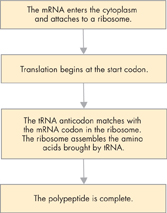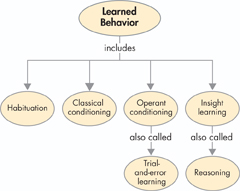Organizing Information
When you study or want to communicate facts and ideas, you may find it helpful to organize information visually. Here are some common graphic organizers you can use. Notice that each type of organizer is useful for specific types of information.
Flowcharts
A flowchart can help you represent the order in which a set of events has occurred or should occur. Flowcharts are useful for outlining the steps in a procedure or stages in a process with a definite beginning and end.
To make a flowchart, list the steps in the process you want to represent and count the steps. Then, create the appropriate number of boxes, starting at the top of a page or on the left. Write a brief description of the first event in the first box, and then fill in the other steps, box by box. Link each box to the next event in the process with an arrow.

Concept Maps
Concept maps can help you organize a topic that has many subtopics. A concept map begins with a main idea and shows how it can be broken down into specific topics. It makes the ideas easier to understand by presenting their relationships visually.
You construct a concept map by placing the concept words (usually nouns) in ovals and connecting the ovals with linking words. The most general concept usually is placed at the top of the map or in the center. The content of the other ovals becomes more specific as you move away from the main concept. The linking words, which describe the relationship between the linked concepts, are written on a line between two ovals. If you follow any string of concepts and linking words down through a map, they should sound almost like a sentence.
Some concept maps may also include linking words that connect a concept in one branch to another branch. Such connections, called cross-linkages, show more complex interrelationships.

Table of Contents
- Formulas and Equations
- Applying Formulas and Equations
- Mean, Median, and Mode
- Estimation
- Using Measurements in Calculations
- Effects of Measurement Errors
- Accuracy
- Precision
- Comparing Accuracy and Precision
- Significant Figures
- Calculating With Significant Figures
- Scientific Notation
- Calculating With Scientific Notation
- Dimensional Analysis
- Applying Dimensional Analysis




